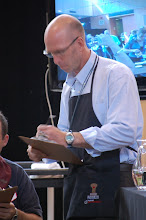Very recently I posted a piece describing how the Commodity Market for Coffee Traders functions as a backdrop to the recent historic highs reached a few weeks ago. One thing I hoped to make clear is the disconnect between those active in the commodity market and those of us consuming specialty coffee. Commodity traders employ leveraged margin accounts to "punch above their weight" and trade contracts exponentially larger than their investments without EVER taking delivery of a single pound of coffee. For these folks, trading coffee, sugar, oil or Swiss Francs is a way of making money, not securing a reliable supply of any of those goods. So why do we still buy and sell specialty coffee fixed off the "C" price?
I ask this question because it is relevant in not only a hot market, but one where the price is confusingly low. It is common to receive quotes for green specialty coffee priced "C" plus $0.75 or "C" plus $1.50 per pound but if the commodity price is fixed in a market controlled by speculative interests, the price will NEVER reflect the actual value to the end consumer. The current system of making a market for specialty coffee references baselines several steps removed from the true value depending on the motivation of the market participants.
The motivations of bidders in the commodity market for coffee is always the same no matter what season, time of year, harvest conditions, retail climate or weather conditions...profit. The market is set up for speculation and leverage which moves the market disproportionately to the amount of real dollars invested. (See my last post of the "C") Money flows into commodities when the yields on other asset classes are significantly lower, risk considered. Right now, purchasing commodities priced in USD, using foreign currency is a perfect hedge against a falling USD. The more the USD falls, the higher the commodities rise. These market movers have nothing to do with quality or consumption, just return on investment. Small moves downward like we've seen in the past week or so are reflective of end of quarter cash outs by large institutional investors, a normal seasonal dip related to coming Brazilian harvest figures, and inflation concerns which drives expectations of higher interest rates/yields on other investments.
So if the "C" is significantly influence by conditions unrelated to the price determinants of specialty grade coffee, why do we continue to reference it when pricing specialty grade coffee? The Cup of Excellence program has done wonders for creating a market for ultra premium coffees employing panels of cupping professionals and consistent criteria for judging plus an open auction. If we are as an industry seeking to improve our skills and offerings, shouldn't we also be moving towards de-commoditizing our pricing references and instead looking to price off a baseline specialty grade price. Creating a specialty grade pricing market would be too small for investors to participate but would reflect the factors we all want to positively influence, price, quality, growing conditions, social factors. I would think that the best way to elevate the condition of farmers in general is to provide an identifiable standard for specialty grade coffee and an active secondary market for it's products. Surely this is a model of democratizing the market for specialty coffee and eliminating the invisible hand with the brass knuckles we all know impacts our commodity prices. We all complained about the low commodity price for coffee, helped organize co-ops, joined Fair Trade, Coffee Kids, and Rainforest Alliance, but the institutional obstacles to fair and quality reflective pricing remained unchanged in the form of the commodity market.
Subscribe to:
Post Comments (Atom)





No comments:
Post a Comment